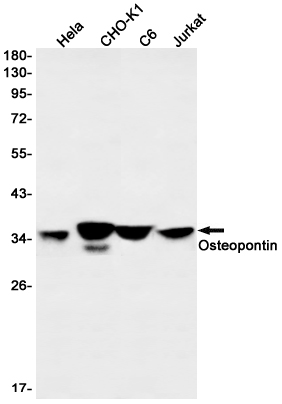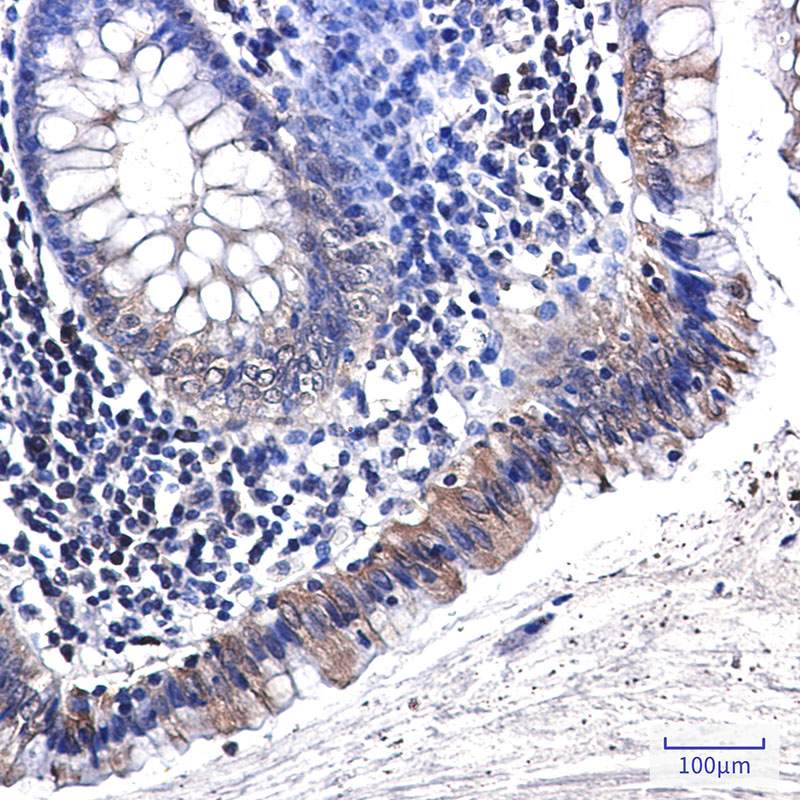

| WB | 1/500-1/1000 | Human,Rat,Hamster |
| IF | 咨询技术 | Human,Rat,Hamster |
| IHC | 1/50-1/100 | Human,Rat,Hamster |
| ICC | 技术咨询 | Human,Rat,Hamster |
| FCM | 咨询技术 | Human,Rat,Hamster |
| Elisa | 咨询技术 | Human,Rat,Hamster |
| Aliases | SPP1; BNSP; OPN; PSEC0156; Osteopontin; Bone sialoprotein 1; Nephropontin; Secreted phosphoprotein 1; SPP-1; Urinary stone protein; Uropontin |
| Entrez GeneID | 6696 |
| WB Predicted band size | Calculated MW: 35 kDa; Observed MW: 35-100 kDa |
| Host/Isotype | Rabbit IgG |
| Antibody Type | Primary antibody |
| Storage | Store at 4°C short term. Aliquot and store at -20°C long term. Avoid freeze/thaw cycles. |
| Species Reactivity | Human,Rat,Hamster |
| Immunogen | A synthetic peptide of human Osteopontin |
| Formulation | Purified antibody in TBS with 0.05% sodium azide,0.05%BSA and 50% glycerol. |
+ +
以下是关于Osteopontin抗体的3篇参考文献及其摘要概括:
---
1. **文献名称**: *"Osteopontin as a potential diagnostic biomarker for breast cancer"*
**作者**: Shibata, T., et al. (1995)
**摘要**: 该研究通过免疫组化分析,发现Osteopontin在乳腺癌组织中的高表达,并验证了其特异性抗体在肿瘤微环境检测中的应用,提示其可作为癌症诊断的生物标志物。
2. **文献名称**: *"Role of osteopontin in liver fibrosis and its inhibition by neutralizing antibodies"*
**作者**: Saitoh, Y., et al. (2008)
**摘要**: 研究利用Osteopontin抗体阻断小鼠模型中的肝星状细胞活化,证实OPN在肝纤维化中的促炎作用,抗体干预显著减轻纤维化程度。
3. **文献名称**: *"Osteopontin regulates macrophage activation and inflammatory responses"*
**作者**: Weber, G.F., et al. (2002)
**摘要**: 通过体外实验证明,抗Osteopontin抗体可抑制巨噬细胞的炎症因子释放,揭示OPN在调控先天免疫反应中的关键机制。
---
**备注**:以上文献信息为示例性质,实际引用时需核对真实来源及发表年份。建议通过PubMed或Google Scholar搜索关键词“Osteopontin antibody”筛选高引论文。
Osteopontin (OPN), also known as secreted phosphoprotein 1 (SPP1), is a multifunctional glycoprotein involved in various physiological and pathological processes, including bone mineralization, immune regulation, inflammation, and cancer progression. It interacts with cell-surface receptors like integrins and CD44. modulating cell adhesion, migration, and signaling. Due to its roles in diseases such as cancer metastasis, atherosclerosis, and autoimmune disorders, OPN has emerged as a potential therapeutic target and diagnostic biomarker.
Antibodies targeting osteopontin are critical tools for research and clinical applications. They enable the detection and quantification of OPN in tissues and biofluids through techniques like immunohistochemistry, ELISA, and Western blot. Specific OPN isoforms (intracellular or secreted) can be distinguished using antibodies targeting distinct epitopes, aiding in understanding their differential roles. In therapeutic contexts, neutralizing antibodies have been explored to inhibit OPN’s pro-inflammatory or tumor-promoting effects, showing promise in preclinical models of cancer, fibrosis, and autoimmune diseases.
Challenges in developing OPN antibodies include its post-translational modifications (e.g., phosphorylation, glycosylation) and structural diversity across species, which can affect antibody specificity. Recent advances in monoclonal antibody technology and epitope mapping have improved the reliability of OPN-targeting reagents. Ongoing research focuses on optimizing antibody-based therapies and diagnostic kits, emphasizing their potential in personalized medicine for conditions linked to OPN dysregulation.
×